History and Background

1897
1917
1930s
1946
1947-1948
1949
1967
1971
1973
1977
1978
First Zionist Congress meets at Basel. Interestingly in the early years there was debate as to where they would set up their Jewish state. The term ‘Zionist’ refers to those who want a Jewish ethnocracy. Not all those who have emigrated to Israel are by any means Zionist. A small contingent of Jews (who spoke Arabic) have lived among their Moslem neighbours in Palestine way back in history in decidedly good relationships.
Nov. Balfour Declaration passed by the UK government supporting the establishment in Palestine of ‘a national home for the Jewish people, …it being clearly understood that nothing shall be done which may prejudice the civil and religious rights of existing non-Jewish communities in Palestine’. The following month the British army under Lord Allenby enters Jerusalem. With the Turkish surrender, Palestine comes under British rule. At the end of WWI the League of Nations formally approves a ‘British Mandate’ over Palestine (at a time when many Arabs wanted an independent state).
Increased emigration to Palestine. (Note the plaque at Tel Aviv airport celebrating ‘Immigration under the British Mandate’!)
Revolt of the indigenous population against the large number of basically European Jews now among them. Britain becomes wary and tries to restrict Jewish immigration and land purchase.
Financially insolvent after the war and unable to solve the fractious situation, Britain says it will withdraw. The UN partitions the land of Palestine, giving 55% to a Jewish state and 45% to an Arab state; this despite the fact that the Jews constituted only one third of the population and owned only 6.5% of the land (largely bought from Palestinians). Palestinians held 91% of the land. The Jews accept but the Arabs (not unnaturally) do not.

Wikimedia Commons
Palestinian Refugee Camp , 1948
4th Geneva Convention. Prohibits collective punishment, cruel treatment & torture, and deportation of civilians under occupation; right of return of displaced persons; outlaws annexation of territory and resettlement by an occupying power of its own civilians on territory under its military control.
Israel refuses to fully withdraw from Sinai in exchange for Egypt’s offer of a peace treaty. Leads to:
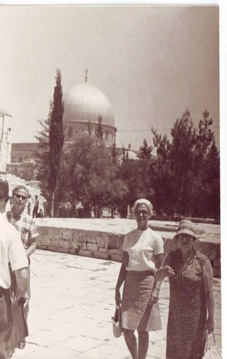
Pikiwiki Commons
An Israeli family visiting the Temple Mount shortly after the 6-day war, 1967
Oct. Yom Kippur war, in which Egypt shows surprising strength; leading to peace treaty with terms similar to what Egypt had offered before the war.
Starting under Nixon/Kissinger, US sole veto of Security Council resolutions affirming a two-state solution. Repeated, 1980; also 1989/2002 General Assembly resolutions. (1967-2008 US casts its veto 42 times to protect Israel.)
First Likud (right wing) govt. Israel.
Camp David accords between Israel and Egypt, followed by 1979 peace treaty.
Wikimedia Commons
General Sir Edmund Allenby enters Jerusalem through the Jaffa gate 1917, famously on foot out of respect for the city.
1982
6 June. Israel intervenes in Lebanese civil war, invading Lebanon where PLO HQ situated. UN mediates ceasefire and PLO evacuated. Sharon says 2K ‘terrorists’ remain in refugee camps and when Israeli-allied Phalangist militia leader + Lebanese president-elect assassinated, IDF encircles Sabra & Shatila camps. On 16 Sept. Israel allowed Lebanese militia to enter camp and a massacre ensued leaving hundreds, if not thousands, dead.
1987
First intifada (means literally ‘shaking off’) insurrection by the Palestinians. Starts in Gazan refugee camps, which together with those in W. Bank house 850K refugees. Very much a grass-roots movt. centred on the villages; farmers crucial; boys throw stones at Israeli tanks; one third of casualties are women. First yr. 400 refugees killed, tens of thousands wounded, by ammunition, rubber bullets, systematic beatings by Israeli soldiers; mass arrests, torture during interrogation.
Sheikh Ahmed Yassin founds Hamas. Military wing formed 1992.
1988
PLO ‘Declaration of Independence’; recognition of Israel within 1967 boundaries.
Madrid conference between Israel and a range of Arab states breaks the ice but had few concrete results. Led to Oslo.
1991
1993/5
Oslo Accords (1993 Oslo I; 1995 Oslo II). A weakened and corrupt PLO signs interim agreements; promised a state by 1999. Interim agreements exonerate Israel for all crimes committed, Israel to cease to bear financial responsibility for acts or omissions and Palestinians must reimburse Israel for any award made against Israel for its past crimes. Israel retains responsibility for external security and for overall security of Israelis; thus free to pursue any Palestinian anywhere. Palestinian police, while having to protect (illegal) settlers and settlements ‘shall under no circumstances’ apprehend, or place in custody any Israeli. Israel has right to close crossing points. W. Bank divided into area A (full Palestinian control), B (joint control), C (all the rest, sole Israeli control). Thus Palestinians left with small non-contiguous, ‘Bantustans’. Edward Said comments Israel ‘achieved all of its tactical and strategic objectives at the expense of the Palestinians’. It gave official Palestinian consent to continued occupation; the PLO agreeing to serve as Israel’s enforcer. PLO grants legitimacy to idea Israel possesses rights in W. Bank, whereas previously international consensus had denied this. W. Bank now becomes ‘disputed territories’. US had undermined Palestinian aspirations for their own state. Meanwhile Oslo allows for rehabilitation of Israel as a ‘peacemaker’. Oslo is but a declaration of principles; all the important points for the Palestinians (right of return of refugees/status of E. Jerusalem/settlements/ water/borders) are to be agreed in ‘final status’ negotiations. So Palestinians gain nothing. Nevertheless many Palestinians initially excited, seeing Accords as a first step to peace and the creation of some kind of a Palestinian state on the W. Bank.
1995 Yitzhak Rabin, Israeli Prime Minister who had signed Accords, assassinated by right-wing Israeli Jew.
In flagrant violation of their signature (Article 31, clause 7: ‘Neither side shall initiate or take any step that will change the status of the West Bank and the Gaza Strip pending the outcome of the permanent status negotiations.’) Israel accelerates settlement building on W. Bank; illegal under 4th Geneva Convention. An utterly disillusioned Palestinian population increasingly deserts the PLO in favour of Hamas. 1994 terror campaign of suicide bombing starts, but reluctance of people to commit themselves; had first been used by Hezbollah in successful campaign to liberate southern Lebanon from IDF control.
Election of Likud government headed by Benjamin Netanyahu. Oslo process finally doomed.
1996
2000
July: Camp David. Clinton + Barak deliver Arafat ultimatum that PLO must formally acquiesce in Bantustan situation (see ‘Solutions?’), or must bear responsibility for collapse of peace process; Arafat refuses, speaking for a Palestinian state based on Israeli withdrawal to pre-1967 borders.
Sept.: ‘Second’ or Al Aqsa intifada. Uprising in response to Clinton/Barak humiliating offer and fear that Arafat might sign some such. Spark that ignites: Ariel Sharon together with a large number of soldiers enter/raid the Al Aqsa mosque, the most provocative action possible. In first few days of the intifada, Israeli soldiers in the territories fire 1,300,000 bullets. Intent was to score a winning blow against the ‘consciousness’ of the Palestinians (Jeff Halper).
After 9/11, US in effect gives green light to Sharon plan to crush Palestinians.
2001
2002
22 March: Saudi Peace Plan. 21 members of Arab League offer normalisation of relations with Israel in exchange for full Israeli withdrawal to 1967 borders and a ‘just solution’ to refugee problem. Israeli lack of response.
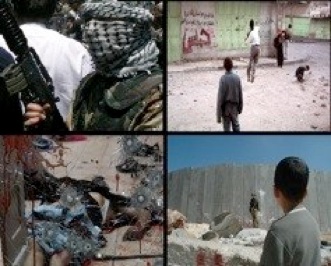
Wikimedia Commons
Montage of pictures from the second intifada.
March/April: massive increase in suicide bomb attacks on Israel. In the course of the intifada more than 3,300 Palestinians killed, at least 85% of them civilians; 50,000 injured, 20% of them children and youth.
April. Arafat’s compound bulldozed; Arafat put under siege.
June: Israel starts to build the wall, known by Israelis as the ‘Separation’ wall; by Palestinians as the ‘Apartheid’ wall (means the same thing). Watchtowers and cameras everywhere.
2002/3
Israel lobbying for invasion Iraq. As condition for supporting US, UK insists on peace plan for Palestine as part of new Middle East world order. ‘Road Map’ endorsed by the ‘Quartet’: US, EU, Russia, UN. Sets out steps to lead to establishment of an ‘independent, democratic, and viable’ Palestinian state by 2005 in return for promise to end terrorist attacks.
2004
Jan.: Hamas offers 10 year truce in exchange for Israeli withdrawal from territories captured in Six Day War and the establishment of a Palestinian State.
March: Israel assassinates Hamas leader Sheik Ahmed Yasser.
April: Bush-Sharon exchange of letters, in which the U.S. signals that Israel will be allowed to keep the settlements in any future peace agreement, thus breaking the international consensus that, in accordance with the 4th Geneva Convention, land-grabbing in war is inadmissible. Endorsed by Congress, the House Resolution (passed 405-7), omitting any reference to a negotiated settlement on a Palestinian state; the Senate Resolution (passed 95-5) asserting it was ‘unrealistic’ for any settlement to require Israel to return to ’67 borders. Condemned by other Quartet partners.
July: International Court of Justice rules that the Wall (separation barrier) violates international law and must be removed.
Nov.: Arafat dies of mysterious illness. His food had to be inspected by Israelis blockading his compound; Palestinian sources suspect he was slowly poisoned.
Mahmoud Abbas elected to replace Arafat as President PA (Hamas boycotts election).
Sharon pulls out of Gaza; about 8,000 settlers leave. But in the following months 30,000 more settlers move to the illegal settlements in the W. Bank. Israel keeps control of Gaza’s borders, land, air and sea, making it a giant prison.
2005
2006
Jan. Hamas landslide victory (76 of the 132 seats; Fatah 43) in free and fair Palestinian parliamentary election and, March, sets up administration. Repeats 2004 offer to Israel. Israel refuses to recognise the democratically elected govt., arresting the speaker of the parliament and all duly elected Hamas members. This meant that the Palestinian legislative assembly could not function, not having a quorum as so many of its members were in prison.
May: US and other govts. impose sanctions on Palestine. ‘It is a bitter irony that Hamas was encouraged, especially by Washington, to participate in the elections to show its commitment to a political process (as an alternative to violence) and then was badly punished for having the temerity to succeed.’ (Richard Falk). ‘A surreal situation thus developed with a significant part of the international community imposing economic sanctions not against the occupier but against the occupied, not against the oppressor but against the oppressed.’ (Avi Shlaim).
June: Subsequent to an explosion on a Gaza beach (responsibility subsequently denied by Israel) Hamas Qassam rocket attacks; Hamas captures Israeli soldier Gilad Shalit; Israel captures 64 Hamas officials.
July: second Lebanon war. Some observers think that IDF’s failure resulted in a determination to deliver a crushing blow on Hamas to recover their reputation.
Sept. In Gaza strip violence erupts between Fatah and Hamas. Oct. Mediation conferences held leading to 13 Nov. both sides agree to form a unity govt.
2007
Feb. Hamas and Fatah form coalition, hoping it will lead to lifting of sanctions.
June. President Mahmoud Abbas dismisses Hamas government; Hamas takes over Gaza to pre-empt an Israeli and American-backed Fatah coup there also. Israel imposes economic blockade on Gaza.
Nov. Annapolis peace conference between PLO and Israel brokered by USA in presence other Quartet members; Hamas boycotts.
2009
2008
June: Egypt brokers ceasefire, to last at least 6 months with hope of extension, between Hamas and Israel, the terms of which were not formally written down. Associated Press reports it as (i) all violence to stop (iii) in stages, starting 3 days later, Israel to ease blockade (iii) in final stage also an exchange of prisoners. Israeli intelligence notes that Hamas careful to maintain ceasefire and is persuading other groups to do so. During course of autumn Israel eases blockade, but very little, in declining amounts. There was a marked reduction in rockets (only 20 rockets were fired at Israel, 3 of which fell inside the Gaza strip, between 19 June and 4 November), and they were fired largely by rogue terrorist organisations in defiance of Hamas. The military expert on the Goldstone commission, Col. Desmond Travers, has commented that in the month preceding Israeli operations the number of rocket that had been fired into Israel was ‘something like two’. Even Israeli intelligence (in a publication ‘The Six Months of the Lull Arrangement’ commented that ‘Hamas was careful to maintain the ceasefire’.
4 Nov. Israeli incursion into Gaza in which 6 Hamas members die. Hamas responds with rocket attacks; Israel virtually closes border. Hamas agrees to extension of truce but on condition Israel cease violating its obligation to lift the blockade. Israel informally proposes 15% of normal supplies; less than the inadequate July level.
18 Dec. UN Gen. Assembly resolution: reaffirming right of the Palestinian people to self-determination including the right to an independent state. Passed 173 in favour, 5 opposed (US, Israel, 3 tiny US-dependent Pacific islands), 7 abstentions.
27 Dec.: full-scale Israeli assault on Gaza. (Gaza). (For a timeline on Israel’s treatment of Gaza click here.)
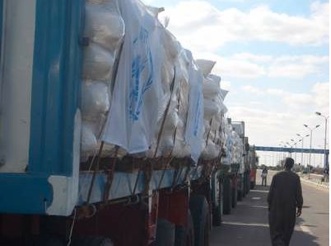
Feb. Israeli elections; no clear victory; Netanyahu forms a hard-line coalition govt.
28 May. Israel snubs Obama, rejecting his call for an end to settlement construction. The Guardian remarks (29 May) that the row ‘reflects the depth of the shift in US policy away from accommodating Israel’.
Flickr Commons, Peter Casier’s photostream
Humanitarian cargo waiting at the Gaza/Egyptian border. 9Jan. 2009.
15 Nov. Publication of the ‘Fact Finding Mission on the Gaza Conflict’ (Goldstone Report) commissioned by the UN Human Rights Council. (Goldstone Report)
2010
Jan. News begins to filter through of Israeli preparations for a further onslaught on Gaza. 67% of Israelis are said to favour this.
19 Jan. Hamas leader Mahmoud al-Mabhouh is murdered in his hotel room in Dubai, the work of a group of persons who have flown in using forged passports of a number of European countries. The Israeli intelligence agency Mossad is generally held to have been responsible.
9 March. During a visit of the American Vice-President, Jo Biden, to Israel/the OPT the Israeli Interior Minister Eli Yishai, leader of the right-wing Shas Party, announces 1,600 new housing units to be built for Jews in East Jerusalem. Visiting the White House, Netanyahu is left to his own devices, Obama saying, re the settlements issue, ‘let me know if there is anything new’; no photographs.
10 May. Israel invited to join the OECD, to which it acceeds 7 Sept. 2010.
30 May. Israel announces that it will be deploying three German-built submarines with nuclear cruise missiles in the Gulf near the Iranian border.
31 May. At 4.00 a.m. Israeli commandos storm the Mavi Marmara, the lead boat in a Free Gaza international humanitarian fleet heading for Gaza, while the convoy is in international waters. The boats, which had been inspected by the Turkish authorities before departure, were carrying medical supplies, construction materials and things for children’s playgrounds. The Israelis employed four battleships, three helicopters, two submarines and 30 zodiac speed boats. From the autopsy evidence, from which the trajectory of the bullets could be deduced, shots came from the helicopters before the Israeli soldiers had landed on the deck; this despite the fact that a white flag had been raised on the top deck. In the ensuing fracas nine passengers, all of them Turkish, lost their lives and many were wounded. Some of the passengers (not unnaturally) tried to defend themselves using cutlery and staves, part of the ships equipment, but they otherwise had no weapons. There follows international outrage. Under intense international pressure, Israel announces (20.06.10) that it will in future allow ‘civilian’ but not ‘dual use’ materials into Gaza, though construction materials will be allowed under international supervision.
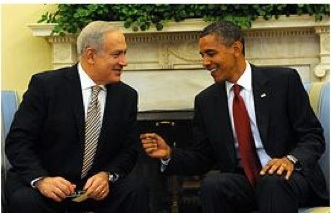
(Israeli) Government Press Office
Meeting of Obama and Netanyahu
Washington DC 06.07.10
2 Sept. Peace negotiations finally get underway in Washington, but by 9 Sept. it is reported that Netanyahu envisages that the peace process will take place over a number of decades! On 26 Sept. the moratorium on settlement building expires.
11 Nov. Astonishingly, in a bid to extend the moratorium for a mere 60 days, the Obama administration in the person of the Secretary of State Hillary Clinton offers the Israeli government a package of incentives: long-term Israeli occupation of the Jordan Valley, fighter jets, and the promise not to extract any further freeze on settlement building before the discussions surrounding final negotiations. Netanyahu turns down the proposal.

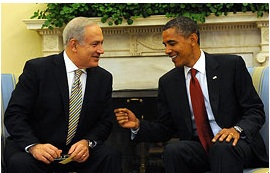
2011
23-28 Jan. Al Jazeera and The Guardian jointly publish papers from the cache of 1,684 documents leaked to Al Jazeera, clearly coming from the (Palestinian) Negotiations Support Unit (for the talks with the Israelis). The documents, from 1999-2010, make evident the depth of the concessions offered by the PA negotiators, the intransigence of the Israelis, the extent of American bias and thus the untenability of the ‘peace process’ given the disparity of power.
8 Feb. PA announces it will hold elections by Sept. 14 Feb. PA cabinet resigns; Abbas expected to form new team of ministers shortly. Moves seen by many as attempt to quell any potential uprisings. Hamas announces it will neither participate nor recognise the outcome, citing suppression of freedoms by the PA security forces and collaboration with the occupation ‘which doesn’t create a proper atmosphere for holding fair elections’.
19 Feb. The US alone vetoes a UN Security Council Resolution declaring Israeli settlements in the West Bank illegal and calling for an immediate halt to settlement building, all 14 other Security Council members voting in favour. The UK Ambassador to the UN, speaking also on behalf of France and Germany, says that the three largest European states hope to welcome an independent Palestine as a new member to the UN by Sept. 2011.
15 March. Thousands of Palestinians demonstrate, demanding reconciliation between Fatah and Hamas. Some go on hunger strike vowing not to eat until unity is achieved. On 27 April, after prolonged secret meetings in Cairo, Egypt succeeds in brokering a deal between the two sides. The previous Egyptian government’s bias against Hamas had made such a deal impossible. Under the agreement: both parliamentary and presidential elections will be held in one year; there will be reform of the security forces and release of prisoners on both sides. In response Israel threatens to withhold the Palestinian taxes which it collects and calls for a suspension of EU aid to the PA.